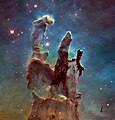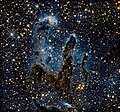File:Eagle Nebula - GPN-2000-000987.jpg

本预览的尺寸:606 × 600像素。 其他分辨率:242 × 240像素 | 485 × 480像素 | 776 × 768像素 | 1,035 × 1,024像素 | 1,944 × 1,924像素。
原始文件 (1,944 × 1,924像素,文件大小:1.18 MB,MIME类型:image/jpeg)
文件历史
点击某个日期/时间查看对应时刻的文件。
| 日期/时间 | 缩略图 | 大小 | 用户 | 备注 | |
|---|---|---|---|---|---|
| 当前 | 2012年10月3日 (三) 00:30 |  | 1,944 × 1,924(1.18 MB) | Ras67 | losslessly cropped with Jpegcrop |
| 2009年4月9日 (四) 01:17 |  | 1,993 × 1,973(1.45 MB) | BotMultichillT | {{Information |Description={{en|1=These eerie, dark pillar-like structures are columns of cool interstellar hydrogen gas and dust that are also incubators for new stars. The pillars protrude from the interior wall of a dark molecular cloud like stalagmite |
文件用途
以下页面使用本文件:
全域文件用途
以下其他wiki使用此文件:
- ar.wikipedia.org上的用途
- arz.wikipedia.org上的用途
- en.wikipedia.org上的用途
- eu.wikipedia.org上的用途
- fa.wikipedia.org上的用途
- hu.wikipedia.org上的用途
- ka.wikipedia.org上的用途
- kw.wikipedia.org上的用途
- mk.wikipedia.org上的用途
- uk.wikipedia.org上的用途





